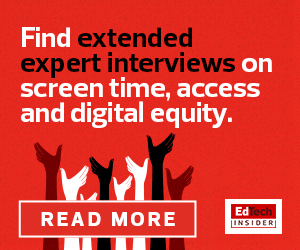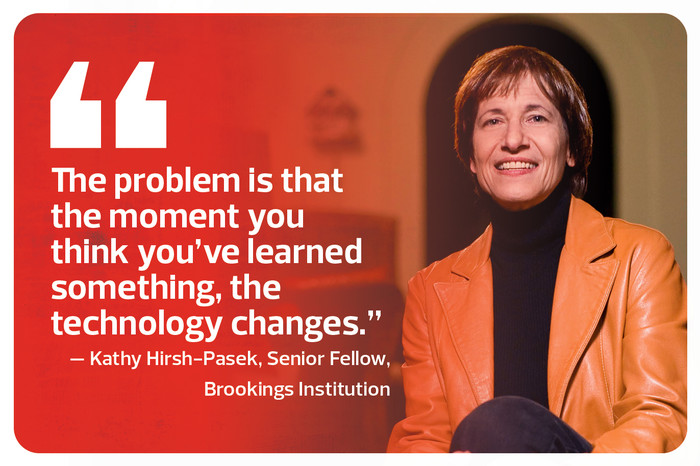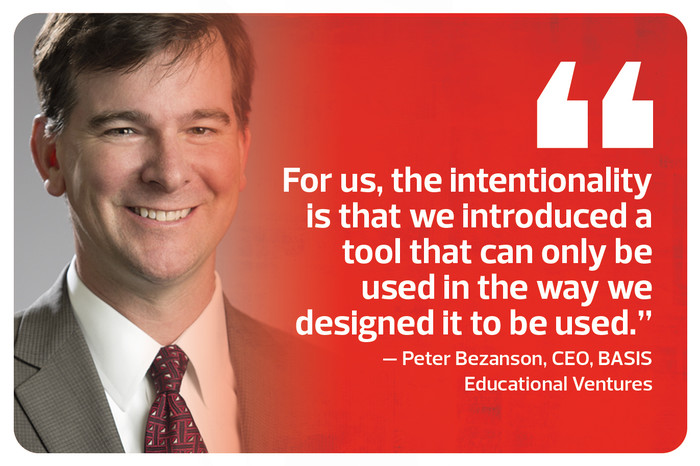The dynamics of digital instruction, learning outcomes and equitable access can be complex, with no one-size-fits-all approach. As researchers learn more about best practices, educators are tasked with putting their findings into practice — a job harder than it sounds. Now, districts are confronting new challenges as they seek to deliver instruction remotely during the COVID-19 pandemic.
We asked four experts to share their views about screen time: Kathy Hirsh-Pasek, a senior fellow at the Brookings Institution and a faculty fellow in psychology at Temple University; Peter Bezanson, CEO of BASIS Educational Ventures; Nicol Turner Lee, a fellow at the Brookings Institution’s Center for Technology Innovation; and Bryan Phillips, CTO of Hoover City Schools in Alabama.
Watch educators from CoSN2020 dispell some related myths about students and screen time.
EDTECH: Research about the effects of screen time varies widely. How would you characterize this issue and the effort to balance technology in schools?
HIRSH-PASEK: We’ve gotten some handle on use patterns. We’re learning as fast as we can. The problem is that the moment you think you’ve learned something, the technology changes. That’s about to happen again with augmented and virtual reality. This is a matter of time and figuring it out.
BEZANSON: As a member of Generation X, I tend to look suspiciously at screen time, but I don’t think the research backs that up. We’ve embraced it when we can control the screen enough for it to be a piece of educational technology rather than a gaming device. We teach kids how to respect the tablet as something from which they can gain knowledge — and to know when to put it away.
TURNER LEE: I’ve had this debate with higher-income parents trying to take tablets away from their kids and make the case that screen time overall is not helpful. Often, the conversation around screen time is done from a middle-class perspective. As a result, we forget that not all children have access to internet-enabled hardware.
What COVID-19 has revealed is that in our important conversations around this topic, we may be missing a few factors, including what access looks like for lower-income students and how many types of devices they have available at home. Research has found that these kids have less access to multiple devices within the home. Our ability to determine whether the kids in Silicon Valley have too much screen time versus the kids in certain parts of Anacostia in Washington, D.C., is really the question that this pandemic is surfacing for school districts struggling to engage in distance learning.


EDTECH: If intentionality is key to the effective use of educational technology, how can educators apply this in practice?
PHILLIPS: The teacher is the most important piece of this. We can give them all the tools in the world, but teachers have to understand not to make an assignment that uses a Chromebook just to use a Chromebook. Make an assignment using the Chromebook as a tool to get where you’re going.
In the classroom, technology can be a magnifier: It takes really good teachers and makes them great, and it takes bad teachers and makes them worse.
HIRSH-PASEK: Our job is to figure out what works well and what does not. Active, engaged, meaningful and socially interactive learning is good. Passive, distracting, not meaningful and solo make something worse. Now we can create a profile and judge it along these criteria, along with how well it meets its prospective learning goal.

BEZANSON: If you just give a student a tablet, you open up a world of distraction. For us, the intentionality is that we introduced a tool that can only be used in the way we designed it to be used. We have a tablet that our middle school kids and many of our high school kids use to access our specialized math curriculum. The platform, called SPORK, can also be customized and used by schools to manage the whole of their curriculum for teachers to design lessons, for schools to monitor implementation of the curriculum and by teachers to push content to student tablets.
Middle school kids are prone to rambunctious behavior, so we had to figure out a way that the tablet could be “stupid” 90 percent of the time. In other words, we didn’t want a smart device in the classroom. We wanted a device that would only connect to the resources the teacher was pushing to it.
READ MORE: Learn how primary students can use technology effectively.
EDTECH: Some educators have concerns about potential negative effects of screen time. Are these concerns legitimate?
BEZANSON: Screens can be really distracting, especially if the student is looking at a screen the teacher can’t see. We’ve gotten to the point now — it’s taken some significant programming — where a teacher can send a link to a YouTube video without allowing them to access the entire YouTube site. Our teachers have embraced it because they know they can send kids to a video without fear of that opening up everything as a distraction.
The “uh-oh” part of this, the notion of tech as a potential distraction, is why we created the program for our students that we did. It’s called SPORK, like the old spoon-fork combo utensil.
It’s a pervasive need in American education and a common topic among educators: finding the balance with tech. That’s why we license our SPORK tech for other schools and districts too. It is a modern need, not yet fully met, due to the rise in the presence of tech in all of our lives.

TURNER LEE: Without appropriate guardrails and guidelines, students will run the risk of creating an imbalance between screen time and physical instruction. I honestly prefer no-cellphone policies in the classroom, which enforce the restriction of personal devices during school time. That allows the teacher to use what the district has made available and define how they want to use devices, which is more productive. But again, we have to keep bringing up the question of equitable access.
PHILLIPS: A teacher needs to be a teacher and take the device away when the device needs to go away. We use tools like GoGuardian so the teacher can lock everybody’s screens at one time. The teacher can just say, “Stop, close the lids, let’s talk about this,” and actually teach.
MORE ON EDTECH: Find out how teachers can better manage classroom computing with GoGuardian.
EDTECH: How do you frame the relationship between technology and equity?
HIRSH-PASEK: Everyone needs to have connectivity right now. We have to offer our children a full palette of what it means to be educated in the 21st century, and that means every kid.
PHILLIPS: We have kids in our district who live in a $300-a-month apartment. We have kids that live in $7 million homes. There’s no doubt that some kids have access to things that the other kids don’t.
It is our responsibility to give students every tool they need. Sometimes it’s fiscally impossible, but we do our best. We had tablets for two years and loved it, but there was no way for us to take files offline. That’s why we went to a Chromebook. Once we got that freedom, that gave us a little more digital equity.

TURNER LEE: The educational community must continue to evaluate the effectiveness of technology in improving student achievement, but there is room to understand the correlation between technology and increased student engagement. How does equity apply to this? In my travels to low-performing schools with technology access, there was a certain enthusiasm among the students, teachers and parents. It was almost like they felt less abandoned when it came to digital resources.
When it comes to ensuring connectivity for students, we must start with their communities, which are often without the needed resources for students to continue their learned digital experiences. Libraries play an important role, but sometimes they are overextended. Based on one’s income and geography, there is a likelihood that they will also lack a home broadband connection. When students do not have internet access, they are starting behind in an economy that has become increasingly digital.
BEZANSON: We don’t have BYOD or an academic program that relies upon a student having internet access at home, because we’ve built our curriculum around a platform on a relatively inexpensive Samsung tablet. It’s affordable for the school to purchase and the material gets pushed to tablets during the school day.
We want a student whose family doesn’t have internet and doesn’t have devices to basically have the same device as a student who lives in a mansion, and those devices access the material in the same way. We use that technology to enforce this sort of equity.

EDTECH: Given that our understanding of access and equity issues will continue to evolve, how can schools best approach this complex issue?
HIRSH-PASEK: This isn’t about saying, “Is screen time bad or good?” It’s about how you use it. It’s like with any other tool. It would sound ridiculous for me to say to you, “Is a screwdriver bad or good?” If you use it as a weapon, it’s bad. If you use it to get a screw out of a wall, it’s great.
PHILLIPS: This is the new norm. We’re seven years into a one-to-one program, and we change policies every year. We change procedures every year. We change devices. Everything’s changing nonstop. You have to be willing to do that. You have to be willing to fail along the way, learn from the failure and move on.
TURNER LEE: Educational institutions should evaluate how they fit into the broader conversations around digital equity. We look to schools for the development of the educational, personal and civic skills of our students. But what about the school’s role in presenting the appropriate digital norms and preparing students for the new economy, which will largely be information-based?
COVID-19 has revealed where there have been blind spots in this approach. I’m looking forward to this conversation continuing as we consider the breakdowns in getting all of our nation’s
students online.
Illustration by LJ Davids















